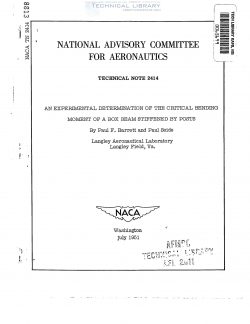naca-tn-2414
- Version
- 87 Downloads
- 402.54 KB File Size
- 1 File Count
- December 14, 2016 Create Date
- December 14, 2016 Last Updated
National Advisory Committee for Aeronautics, Technical Notes - An Experimental Determination of the Critical Bending Moment of a Box Beam Stiffened by Posts

An experimental determination of the critical bending moment of a
box beam stiffened by posts is described and discussed. The experi—
mental buckling load is in good agreement with that given by theory.
Since appreciable distortion of the beam cross section occurred befbre
the buckling load was reached, modification of post construction by
the use of several ribs may be necessary for maintenance of the rec-
tangular shape of the cross section.
A theory for the stability of an idealized box beam stiffened by
posts and subjected to pure bending was presented in reference 1. In
that paper a trial design was made in which the box-beam compression
cover would buckle with transverse nodes through the posts. The weight
of post stiffening required to stabilize the compression cover was
found to be very small compared with the weight of the compression
surface, and a considerable saving of weight appeared to be obtained
by the use of post stiffening rather than conventional rib—stringer
construction if the amount of stiffening were adequate for actual
box beams.
The idealized structure assumed in the theoretical analysis is
different from an actual box beam stiffened by posts. For instance,
actual box-beam covers are restrained by the webs; whereas the theory
assumes that the covers are simply supported. The applied moment
causes the box beam to bend; whereas the theory assumes that the covers
are subjected to tensile and compressive loads but remain flat. An
actual box beam may therefbre buckle in a manner much different from
the theoretically predicted behavior and the critical load may be
materially changed.
In order to obtain some idea of the behavior of an actual box beam
stiffened by posts, a box beam similar to that designed in reference 1
was constructed and tested. The details and results of the investiga—
tion are given in the present paper.
The details and dimensions of the test specimen are shown in
figure 1. The tension and compression covers of the box beam are of
equal thickness and are riveted to two channels. Three rows of equally
spaced pOsts connect the two covers. The weight of the posts, including
all attachment material, is about 6 percent of that of the compression
cover.
| File | Action |
|---|---|
| naca-tn-2414 An Experimental Determination of the Critical Bending Moment of a Box Beam Stiffened by Posts.pdf | Download |
Comment On This Post